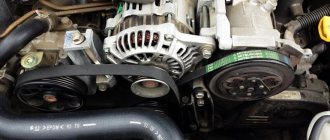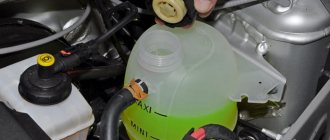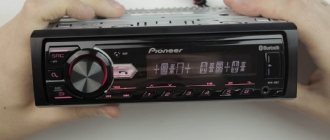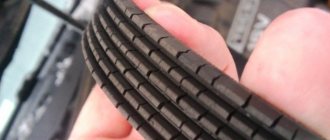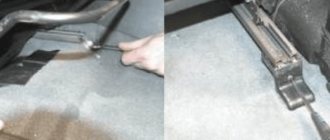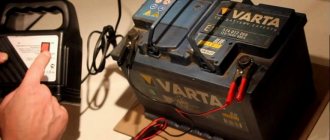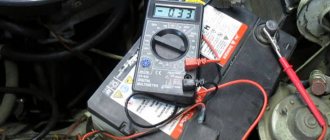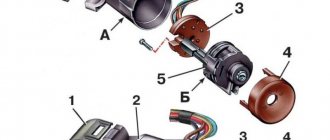The battery is one of the main elements of a car. An energy source with a capacity of 12 volts supplies electricity to start and operate the engine and car electronics. Powers the alarm when the engine is turned off. Sometimes it is necessary to remove the battery for recharging, maintenance, winter storage or replacement with a new battery. It is important to know how to remove the battery correctly. When removing the battery for the first time, it is recommended that you read the instructions for the car.
Preparing for work
Before starting work you must:
- Turn off the headlights, air conditioning, heater, player, on-board electronics and other energy consumers.
- Turn off the ignition and put the key in your pocket so that there are no problems associated with getting into the car with the battery disconnected.
- After turning off the ignition, turn off the ground switch, if the car has one. This will protect the on-board computer from power surges and accidental short circuits.
- Wear long sleeves and gloves to protect yourself from accidental burns if battery acid comes in contact with your skin.
Why do you remove the battery for the winter?
Guys, everything is simple here - they remove it so as not to “kill” the battery! If the car is not in use, but the terminals are connected to the battery, then the discharge microcurrents are still present, of course, for some the leakage is much larger, for others it is much smaller, but in any case it is present (by the way, how to check it, read here ). Also, do not forget about self-discharge currents; even the most ideal battery can discharge itself during a long period of inactivity. YES, to be honest, batteries are not always clean on top, that is, they may contain dirt, moisture (for example, precipitation, evaporation, etc.), antifreeze and much more. All this can drain the battery, albeit slowly but surely.
Battery location
The battery is not always located under the hood next to the engine. In some cars, the battery is located under the driver's seat or under the rear seat. To remove the battery from under the seat, you need to partially dismantle it using 8 and 13 mm wrenches.
On a Citroen Xsara Picasso, for example, keys are not needed to remove the battery from under the seat. The chair is equipped with different levers for easy access to the battery. In German cars the battery is often installed in the trunk. In some cars, the battery is located under the front or rear fender. You must first remove the wheel or remove the bumper, then just remove the battery.
If the battery is not in its usual place, you can look in the car manual or find out via the Internet the location of the battery in a given car model.
Required Tools
To work, you will need 8 or 10 mm ring wrenches to loosen the terminals and 12 or 13 mm to remove the fixing tie. A rag will help to remove dirt and dust.
Case No. 4. Leakage currents are higher than normal
This case has already been mentioned in the paragraph about charging the battery. However, large leakage currents can be harmful for another reason. Namely, when the car has incorrectly connected or partially broken devices that consume electricity from the battery when the engine is turned off. Such losses can lead to the fact that a completely working battery will go to zero even overnight. Or rather, it will lose charge for several days, not having time to restore it during short trips, and one morning it will fail.
In such cases, it is recommended to disconnect the terminal from the battery, even if it is new and holds a charge 100% well. It should also be noted that such actions should be a temporary precautionary measure. If there are large leakage currents, then their cause must be sought without postponing this matter. To identify consumers who drain the battery during relatively short stops, you need to connect an ammeter to one of the battery terminals with the engine off, and remove the fuses one by one. At which fuse the leakage current decreases, the fault must be looked for in that circuit.
Let us recall that the normal leakage current is considered to be within 70 mA. There should be no more, even in a car “stuffed” with electronics.
Is it possible to remove the battery from a running car?
It is strictly forbidden to remove the battery while the engine is running.
When the car is running, the battery plays the role of a voltage stabilizer. When the terminals are disconnected, the voltage surge produces a welding arc between the terminal and the battery terminal.
The consequences can be irreversible: failure of the synchronous generator, battery, and all electronics. There is also a high risk of fire. According to experts, it is possible to remove the battery from old Soviet-made cars, for example the Volga, while the engine is running.
On forums, many people share their successful attempts to remove the battery while the engine is running, but is it worth the risk?
Removing the battery for the winter: a mistake or a necessity?
If you use your car relatively rarely in winter, that is, it sits idle for weeks, removing the battery is absolutely justified. Even in summer, a battery that is not in use loses its charge over time due to microcurrent leaks, which are present even on a new car. At negative temperatures, such phenomena intensify many times over. It is not without reason that experts advise charging the battery with an external charger at least once every two weeks during the cold season, even if the car is used intensively.
So the answer to the question whether it is possible to remove the battery from the car for the winter if it will be idle a lot is affirmative. Moreover, many drivers, if severe frost is expected, remove the battery even at night, and this behavior is absolutely justified. Another thing is that not everyone has such an opportunity, and more often they are simply overcome by laziness.
How to properly remove the battery from a car
It is necessary to gain access to the battery depending on its location, then remove the fabric thermal protection and the plastic noise insulation casing, if any. Take a break for a few minutes to allow the electrolyte vapors to dissipate.
Some people don’t see the difference in whether it’s a plus or a minus to remove from the battery first. Determining plus and minus is not difficult: the positive terminal always has a red wire. The battery has + and - marks. First of all, you need to disconnect the ground, the negative terminal, in order to open the electrical circuit and de-energize the car body.
If you disconnect the positive first, a short circuit in the circuit will be fatal.
Also, if metal parts of a car or a tool accidentally come into contact with the positive terminal, electrical burnout may occur. When the minus is disconnected, no short circuit will occur.
Is it possible to shoot with the engine running?
There are two camps here - some say that it’s possible and nothing bad will happen, others that everything that can be burned will burn!
Personally, I think that you can remove the battery for a short time, for example, to start a neighbor’s car that is completely dead (and there are no wires for lighting), then quickly remove it and put it back.
By the way, in this way you can check the functionality of the generator, watch my video (if you don’t want to wait, skip straight to 14:21 minutes).
BUT you should do everything VERY CAREFULLY, let’s go point by point:
- Short circuit . Actually, when the engine is running, the generator generates electric current; accordingly, the plus terminal goes to the plus, and the minus terminal goes to the minus. If you remove the battery, DO NOT IN ANY CASE ALLOW the positive terminal to come into contact with the car body, otherwise a strong short circuit will occur, and then all the wiring and electronics may burn out! After all, the generator can produce quite strong currents. That is, the positive terminal must be isolated from the metal parts of the body, because it is through it that the mass flows, that is, the negative part is connected.
- Voltage fluctuations. Many people wrote to me that “when you remove the terminal, all the electrics can burn out (and it’s not even a short circuit), but simply from a power surge.” I think this is, to put it mildly, “not true.” Why? I justify it - look, a generator is not a “dumb” dynamo machine, it is essentially a very smart unit, it has a special “ voltage regulator relay ”. What it does is simply stabilize the voltage, that is, it does not allow it to exceed the 14.5 Volt level. After all, in fact, a generator at high speeds can produce 15 or even 17 Volts, such a voltage will be destructive for most devices, so this regulator “stabilizes” by cutting off excess voltage from above. So, if we remove the battery, then again nothing bad will happen, the voltage in the network will remain the same as it was from 13.8 to 14.5 V. DAMN WELL, WHAT SHOULD HE JUMP FROM? If you want to play it safe a little, you can give a load in the form of headlights, a stove, heated windows and seats, then the voltage will drop to about 13.7 - 14V, that's all! And in fact, the battery is nothing more than a current consumer (load); if it is undercharged, it receives charging from the generator; if it is charged, it receives nothing! WHY DOES IT ALL HAVE TO BURN, PLEASE EXPLAIN?
- Wiring. The wiring is also “nonsense”, it won’t melt, nothing will happen to it. Again, the voltage regulator stabilizes everything. If you follow this logic, then if the terminal on the battery has oxidized and the charge does not flow into the battery, that is, it is, as it were, disconnected (all your electrics will burn out and all the wires will melt), isn’t it nonsense?
Therefore, nothing will really happen to your generator if you remove the battery from a running engine. THE MAIN THING TO REMEMBER IS THE POSITIVE TERMINAL.
That's all, I think the information was useful to you, read our AUTOBLOG, subscribe to the YOUTUBE channel.
( 22 votes, average: 4.09 out of 5)
I don’t know how true this information is, but read it anyway!
So, the cold weather is coming soon and in connection with this, many will want to remove the battery in order to recharge it, or maybe even change it altogether. When the battery is removed, the computer is reset and current data on the operation of the sensors is erased. This is where the main problem lies. Since when installing the battery back, the basic conditions for the normal further functioning of the car are not met. In search of information on the correct steps to connect a new battery, the following sequence of the correct process for replacing the battery emerged, so that the engine would subsequently please with its operation and not cause trouble. 1. Warm up the engine to operating temperature, preferably while driving. 2.Remove the NEGATIVE terminal from the battery for 3 minutes, the computer memory will be “reset to zero”. 3. Reinstall terminal 3a. If the battery was completely removed, first connect the POSITIVE terminal 4. WITHOUT touching the gas pedal, start the engine. 5. Warm up for 10-15 minutes, information is collected from the sensors of the on-board systems. 6. Turn off the ignition to record data into the computer memory. 7. Start the engine and accelerate to 50-60 km/h, followed by a complete stop. 8. Turn off the ignition to record data from speed sensors, gearboxes, etc. into the computer memory. working while moving. 9. We start the engine and go get a beer, regardless of the result :))) I apologize that it turned out to be so much
Found another article from a different author!
How to remove terminals from a battery
The removal sequence must be strictly followed:
- Using an 8 or 10 mm wrench, loosen the negative terminal without unscrewing it completely. Carefully remove. If the terminal does not budge, you must carefully twist it left and right, then remove it. It is recommended to wrap the removed terminal with polyethylene or fix it to prevent accidental short circuit.
- Then loosen and remove the “plus” terminal in the same way, insulate it with polyethylene or fix it. If, when removing the positive terminal, a spark jumps between it and the contact, it means that not all devices are turned off or the car’s wiring is faulty.
- Using a 12 or 13 mm wrench, unscrew and remove the fastener securing the battery.
If the terminal is stuck
If there is incomplete contact between the terminal and the battery or if moisture gets on the contacts, a spark that appears under load solders the contact. A white coating indicates that the terminal is stuck.
If the terminal cannot be removed and is covered with a white coating, do not knock it down or knock on it!
The battery terminal or housing and plates may be damaged. It is necessary to carefully remove the plaque with a stiff non-metallic brush. It is useful to use WD 40 fluid. Then carefully twist left and right and, using a screwdriver as a lever, remove the terminal. Afterwards, be sure to remove any remaining liquid from the contacts and clean the terminal from deposits.
Case No. 9. Replacement of ignition system parts
Spark plugs, armored high-voltage wires, coils and so on. Should I disconnect the battery when replacing these parts? Again, there are two opinions. Some say that it should be turned off. Others argue that while the ignition switch is turned off, no voltage can flow to parts of the ignition system from an undisconnected battery.
And again, both sides are right in their own way. The voltage really will not go to the spark plugs, coils and high-voltage wires if the ignition is turned off. But in addition to the fact that the lock is turned off, it must be fully operational. Also, no one should accidentally turn on the ignition while replacing all of the above. Oddly enough, this happens, for example, when one is fiddling with spark plugs and wires, and the other, in order not to waste time, finally decided to connect the radio correctly by “running” the ACC wire through the ignition switch.
There are many such examples that can be given. Therefore, in order not to be included in this list, it is better, after all, to remove the terminals in this case as well.
Possible difficulties when removing the battery
In a car with an injector and on-board electronics, after removing and installing the battery, all saved data is often reset. It is better to entrust battery removal from premium and elite class cars, for example, Porsche, Opel, Mercedes, BMW, Volkswagen, Jaguar, Citroen, Bentley, to the specialists of the service station of an official dealer. With the majority of foreign cars equipped with an electronic control unit, there will be no big problems. All you have to do is set the time on the clock and tune the radio.
When the battery is disconnected, the alarm can turn on the alarm mode, closing all doors and activating the siren. Be sure to turn off the alarm before removing the battery. You can leave one door open. After returning the battery to its place, you need to check the operation of the alarm. If the radio has a security PIN code, you need to make sure that it is entered, otherwise after reinstalling the battery you will have to configure the functions again.
Case No. 5. The battery is “tired”
In this case, the battery must be disconnected for the same reason. If the battery is already old and does not hold a charge well, then in order not to “finish off” it completely, when the car is idle for more or less long periods, the terminals must be removed (one negative one is enough).
Otherwise, the battery will often let you down. But this is not the saddest thing. In addition to unreliability, due to regular deep discharges, the battery in a matter of days will lose the capacity that it has left after long-term use. Such an energy source should, of course, be replaced with a new one. But if you want to get the most out of its resource, then removing the terminals will really help in this matter.
Safety precautions
During battery operation, hydrogen is released, which can explode from a small spark. All work with the battery must be carried out outdoors or in a well-ventilated box.
The battery is very heavy - the handle may not hold it. Properly hold the battery by the bottom when carrying it.
If acid battery electrolyte gets on your skin or clothing, immediately rinse the damaged area with a solution of baking soda or plenty of water.
Alkaline battery electrolyte that gets on your skin or clothing is neutralized with a 10% solution of acetic acid or citric acid.
Case No. 6. Long-term car parking
Here it absolutely does not matter how fresh your battery is, or whether the leakage currents are normal. If the car will not be used for a significant period of time, for example, you went on vacation for a couple of weeks, the terminals must be disconnected. This recommendation is especially relevant in winter. In the cold, a discharged battery will literally freeze, since due to a decrease in density, the non-freezing electrolyte will turn into water and rupture the battery case.
How to calculate how long your battery will last if no one touches the car? To do this, you need to know only two things - the leakage current when idle, as well as at least the approximate capacity of the battery. It’s easier with new batteries, since their capacity is written on the case. It’s more difficult with those who have already traveled, since their capacity can only be determined by measuring it using special devices.
It is considered very simple. Let's give an example for clarity. Let's say we have a battery installed with a capacity of 50 ampere-hours. We measured the leakage currents when idle, and found out that they are normal - 50 mA. In this case, it turns out that 50 mAh of energy will be lost from the battery in one hour, 24*50 = 1200 mAh or 1.2 Ah in one day, and so on. For example, if you leave such a battery with such leakage currents for two weeks, then theoretically it will lose 1.2 * 14 = 16.8 Ah of charge out of 50 Ah. But this is if you left a 100% charged battery, which actually has such a capacity.
In most cases, batteries do not have such capacity due to natural wear and tear or improper use. Therefore, a deep discharge can occur much earlier. Hence the conclusion - we don’t drive for a long time, which means we disconnect the terminals.
How to lock or open a car without a battery
The alarm key fob will not be able to open or close a de-energized car. You should always have a regular key in stock. You must lock all doors and trunk with the key. Foreign cars most often have one lock cylinder. On the inside of other doors, above the handle, there is often a key that blocks the door lock.
You need to press a key and slam the door. In other options, a special switch located at the end of the door under a plastic plug will allow you to close the door. You need to insert the key into the hole, turn it clockwise until it stops, remove the key and slam the door.
After installing the battery in place, the door will open using the remote control.
Removing the battery is easy. The main thing is to strictly follow the sequence of operations. Owners of cars with on-board electronics should still contact specialists.

